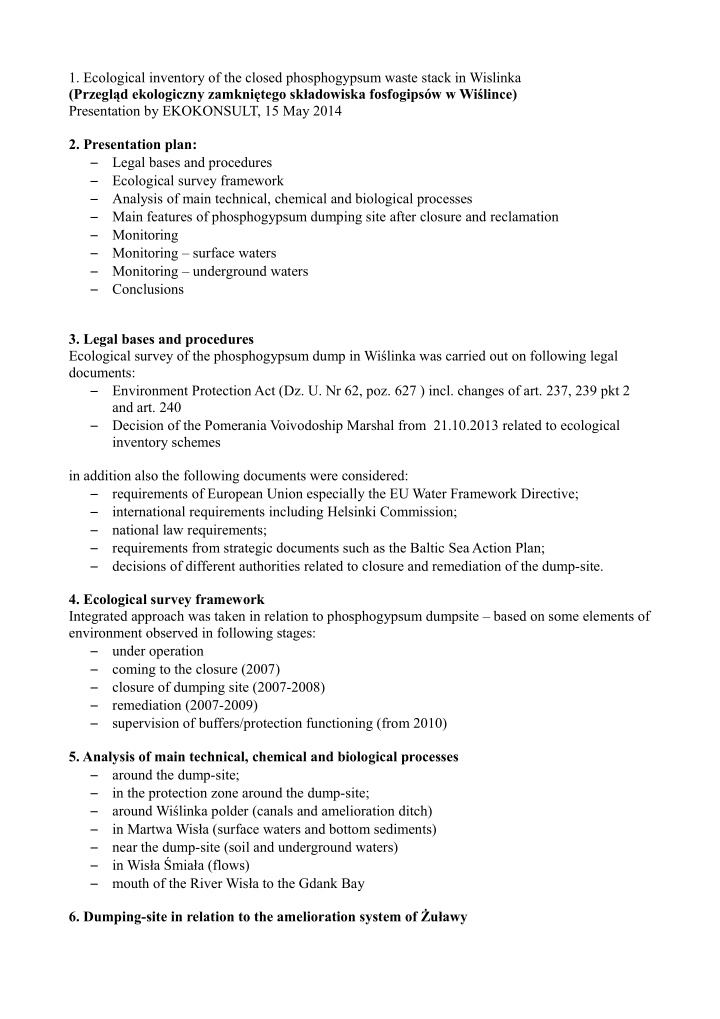



1. Ecological inventory of the closed phosphogypsum waste stack in Wislinka (Przegląd ekologiczny zamkniętego składowiska fosfogipsów w Wiślince) Presentation by EKOKONSULT, 15 May 2014 2. Presentation plan: – Legal bases and procedures – Ecological survey framework – Analysis of main technical, chemical and biological processes – Main features of phosphogypsum dumping site after closure and reclamation – Monitoring – Monitoring – surface waters – Monitoring – underground waters – Conclusions 3. Legal bases and procedures Ecological survey of the phosphogypsum dump in Wiślinka was carried out on following legal documents: – Environment Protection Act (Dz. U. Nr 62, poz. 627 ) incl. changes of art. 237, 239 pkt 2 and art. 240 – Decision of the Pomerania Voivodoship Marshal from 21.10.2013 related to ecological inventory schemes in addition also the following documents were considered: – requirements of European Union especially the EU Water Framework Directive; – international requirements including Helsinki Commission; – national law requirements; – requirements from strategic documents such as the Baltic Sea Action Plan; – decisions of different authorities related to closure and remediation of the dump-site. 4. Ecological survey framework Integrated approach was taken in relation to phosphogypsum dumpsite – based on some elements of environment observed in following stages: – under operation – coming to the closure (2007) – closure of dumping site (2007-2008) – remediation (2007-2009) – supervision of buffers/protection functioning (from 2010) 5. Analysis of main technical, chemical and biological processes – around the dump-site; – in the protection zone around the dump-site; – around Wiślinka polder (canals and amelioration ditch) – in Martwa Wisła (surface waters and bottom sediments) – near the dump-site (soil and underground waters) – in Wisła Śmiała (flows) – mouth of the River Wisła to the Gdank Bay 6. Dumping-site in relation to the amelioration system of Żuławy
– borders of the polders – damping-site 7. Scheme of main elements of the dumping-site and elements of the hydrological protection
8. Crucial features of the phosphogypsum dump after closure and reclamation: – dump area 26 ha – inner belt – embankment surrounding the inner belts – 2 external belts – „clay corks” blocking water ouflow into ameloration canals – leatache retention storage (area of 2,2 ha) – pump taking leatache to retention storage 9. Scheme of functioning system for preventing outflow of surface waters 10. Monitoring Surveys of the Voivodeship Inspectorate of Environmental Protection in Gdansk Inspectorate and surveys of the Laboratory of the Gdansk Phosphor Fertilizers Production (GZNF) during the post-production time 2008-2013 contain following: – atmospheric fallout – subsidance of dumping-site area – stability of dump – flow of surface waters of Martwa Wisła – Martwa Wisła waters survey – leachate waters in retention storage survey – amelioration system of waters survey – underground waters around dumping site survey 11. Location of sampling sites of GZNF FOSFORY Ltd. around the phosphogypsum dump in Wislinka and control points of Pomeranian Voivodeship Inspector of Environmental Protection in Gdansk (WIOŚ) .
13. Monitoring – surface waters Results of pH level in surface waters during 2010 – 2013 13. Monitoring – surface waters Results of phosphates survey [mgPO4-3/dm3] in surface waters of Martwa Wisla during 2010 – 2013
14. Monitoring – surface waters Results of fluorides survey [mgF/dm3] in surface waters during 2010 – 2013 15. Monitoring – underground waters Results pH level survey in underground waters during 2010 – 2013
16. Monitoring – underground waters Results of phosphates survey [mgPO4-3/dm3] in underground waters during 2010 – 2013 17. Monitoring – underground waters Results of fluorides survey [mgF/dm3] in underground waters during 2010 – 2013 18. Conclusions (1) – closed and reclaimed phosphogypsum dump in Wiślinka currently is not a source of pollution linkage to the environment. – Pollution load washed out during functioning of the dumping-site is concentrated under the dump in a soil-water site. Spacial range of surface waters, shallow underground waters and soil migration is limited by the hydrological barrier. – Concentration of monitored pollutions in surface waters and underground waters sustains in acid–base homeostasis, there is very low level of fluorides ions and stable decreasing trend of phosphates. 19. Conclusions (2) – Impact of soil-water site in the area of phosphogypsum dump on the environment is cumulative with other impacts (agriculture, urban areas, harbour, industry) and has a cyclical character of bio-chemical changes in sediments and waters of Martwa Wisła. – Results of survey of Martwa Wisła waters and its sediments demonstrate improvement of environment condition in comparison with the period of exploitation of phospogypsum dump.
– Water flow in Martwa Wisła and Wisła Śmiała results in seasonal river waters intake to transitional waters of Gdansk Bay. – Load of phosphates inflow to the Gdansk Bay with waters of Wisła Śmiała is insagnificant in comparison to load of 3000 Mg phosphates per year coming from the main outflow of the River Wisła mouth from 60% of territory of Poland. 20. Thank you for your attention Andrzej Tyszecki B.P.D. EKO-KONSULT 80-328 Gdańsk, ul. Kościerska 5 tel. 058/ 554 31 38, fax. 058/554 31 39 e-mail atyszecki@ekokonsult.pl www.ekokonsult.pl
Recommend
More recommend